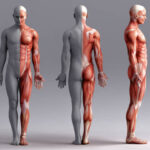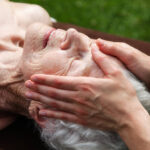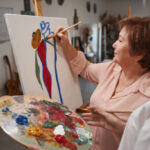Since I was a child, I always liked to get massages. With the arrival of mental illness in my life, and the isolation that accompanies this condition, this need has become more present. Therefore, when my finances would permit it, I would occasionnally get a massage. This would be beneficial for me, whether my mood would be high, the massage reduced my hyperactivity. When my mood was low, being touched made me feel good, which would diminish my stress and lessen my depressive symptoms.
In a way, being touched sends a message to the brain that you have value and gives you self-confidence. Every day I see how common isolation, stress and depression are among my peers, this is why mental health massage therapy has every reason to grow.
An art and a science
But not everyone can improvise as a massage therapist; massage therapy is an art and a science that requires a love of touch, the mastery of specific techniques as well as knowledge of human anatomy and physiology. This is why the Quebec Federation of massage therapists (QFMT) considers it important to bring together (certified) massage therapists trained with the highest quality standards.
This article aims to paint a portrait of the QFMT as well as to deepen your understanding of this organization. The QFMT is a non-profit organization (NPO) that works with various populations, including the elderly, people with mental health problems, and more.

The QFMT...in short !
But before telling you about the benefits of massage for various populations, let me introduce you to the QFMT. As I said above, the QFMT is a non-profit organization with its own board of directors. It offers support to its members if they have questions, for mentoring and help with professional development. It makes it possible to create links during conferences or the Annual General Meeting (AGM). Each massage therapist-member has their own approach, but the QFMT makes it possible to identify a common language based on evidence and best practices. It should also be noted that in 2010, the QFMT created the Massotherapy Foundation, whose mission is to provide well-being through massage to people seriously affected by different diseases.
Sylvie Bédard
Sylvie Bédard, who is a native of Saguenay-Lac-St-Jean, is a social entrepreneur who has committed herself, during her professional career, to marginalized people, such as prostitutes, women victims of domestic violence, people with mental health problems and seniors in CHSLDs. She joined the QFMT in 2006 and is currently Chair of the Federation's Board of Directors. Currently, Sylvie Bédard is continuing her efforts with government authorities to regulate massage therapy in Quebec. She also began training in massage therapy.
Partnerships (elderly population and mental health)
First of all, when the QFMT began, an alliance with the Cancer Foundation was set up to support people with cancer and living in nursing homes.
The QFMT is thus a body to help the aging population. Indeed, the management of the QFMT has received multiple requests from CHSLDs for these two entities to work in collaboration. The CHSLD foundations are ready to finance massages (the CHSLD foundations pay 50%, the QFMT pays 50%). Although this start-up model is promising, the QFMT sometimes lacks the funds to properly serve this population. Be that as it may, massages in CHSLDs must be performed extremely gently since seniors have very thin skin.

In terms of mental health, in 2015, the QFMT built a community partnership with Les Impatients, an art therapy organization. The users were relatively autonomous and followed on an outpatient basis. They indulged in art therapy while receiving massages on an occasional basis. The responses were very positive as users kept coming back.
However, this year, the QFMT massage therapist practicing at Les Impatients left the art therapy organization to devote herself to an innovative practice in a psychiatric unit at the CHUM. She is excited by this new professional challenge, and she looks forward to interacting with other types of therapists, who are observant of the changes in users.
In addition, in the perspective of a break in service to the Impatients, a massage therapy pilot project at the University Institute in Mental Health of Montreal (IUSMM) was mentioned, but for lack of money, the project aborted.
Hence the need to invest more funds to establish partnerships between the QFMT and mental health organizations. And also the need to train more massage therapists who are interested in mental health.

Massage therapy
In addition to helping to circulate fluids (arteries, veins, lymphatic fluid), massage therapy can be beneficial in the case of Alzheimer's disease. Indeed, with this disease, communication becomes difficult. But the benevolent touch of the aging body remains. Beyond physical and mental deterioration, there is always a possibility of touch: massaging hands, feet, head, face. Massage can also help a loved one to leave peacefully.
In mental health, the issues of trust are paramount, and the approach must be done gently. Being global and holistic, massage therapy allows the person with a mental health problem to reduce tension, reclaim their body and focus less on their mind. The massage therapist must also take into account the person's mood, sensory hypersensitivities and the taking of psychotropic medication.
Trager approach
The Trager approach is a very gentle approach and is ideal for people with a mental health problem. Indeed, it gives ease to movement and relaxes while energizing. During a Trager session, the person passively performs rocking, stretching and vibration movements with the help of the massage therapist. She experiences the immense pleasure of refocusing on herself, in harmony with body and mind.
The Trager massage therapist does not intervene where the person is in pain, because there will be no response from the person, or even some restraint. So the practitioner's approach is to go to places where they can bring pleasurable sensations to the nervous system, which ultimately improves mood.
Louise de Montigny
Louise de Montigny has been a massage therapist for 40 years and she is one of the pioneers of massage therapy in Quebec. A psychologist by training, she worked in social services for five years. This work was not entirely satisfying for her, since she was constantly in a hurry to solve problems. She became interested in approaches in psychology where touch intervenes like bioenergy. Louise de Montigny wondered to what extent we can intervene through the body, if we want to reach a person's emotions, for example. She learned different types of massage, such as Swedish and Shiatsu, until she came across the Trager approach (see above).
Massage therapy with different clients
Other than the elderly and persons with mental health issues, the massage thearpist of the QFMT intervene with a variety of clients: healthy persons that are stressed or have headaches, cancer, chronic pain and musculoskeletal disorder, arthritis, children having special needs (autism, attention deficit disorders with or without hyperactivity) and pregnant immigrant women.
As for cancer, the medications for cancer treatments cause pulmonary oedema and a loss of mobility. Massage therapy helps to cure the pain caused by treatments.
Furthermore, the massage therapists of the QFMT intervene where there is chronic pain, particularly the chronic pain of the University of Montreal health center (UMHC). We can find conditions such as fibromyalgia, work accidents, repetitive movements, etc. For it to be categorized as chronic, the pain has to last for three months. The massage gives relaxation that diminishes the pain: « It's as if I would distance myself from my pain ».

Finally, the QFMT intervenes also in social perinatal, namely the pregnant immigrant women. The massages are mainly done for traumas as a result of pregnancies, post-partum depressions and physical problems that derive from them. The massages are done on the parents and not on the babies. One can hope that the women who receive a beneficial touch will touch their child in a compassionate way.
Create a professional order: why ?
Being behind compared to other Canadian provinces, the QFMT is a militant for the creation of a professional order of massage therapists in Quebec. This would ensure the quality of the profession and also accountability (public protection).
But why is there resistance in Quebec ? According to a massage therapist, there is not a unity of thought neither a consensus from the population. There has to be a political will. One has to prove that the bad practice can be harmful for the person. There are also very few public schools that teach massage therapy: it's more private schools. A public educational program would democratize massage therapy and would help to create a professional order.

Altogether, we hope that the militant actions of the QFMT will materialize and that the government of Quebec will have the political will, like its provincial counterparts, to create a professional order of massage therapists.

Louise de Montigny se demande jusqu’à quel point on pouvait faire intervenir le cours pour rejoindre des émotions. Intéressant! Je me souviens que lorsque j’étais jeune, je suivais une thérapie qui s’appelait L’Abandon Corporel et c’était exactement cela. Cette thérapie faisait intervenir le corps pour rejoindre les émotions réprimées en nous.
Oui, le massage est très bénéfique. Je me demande si la danse thérapie peut aussi aider…